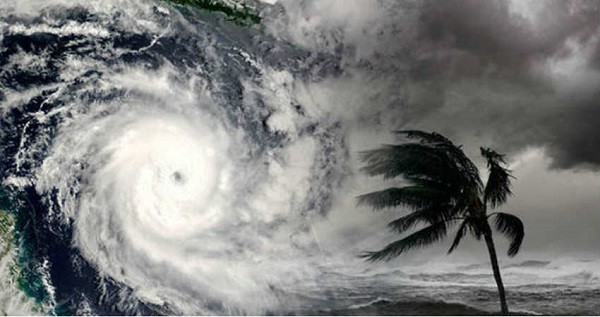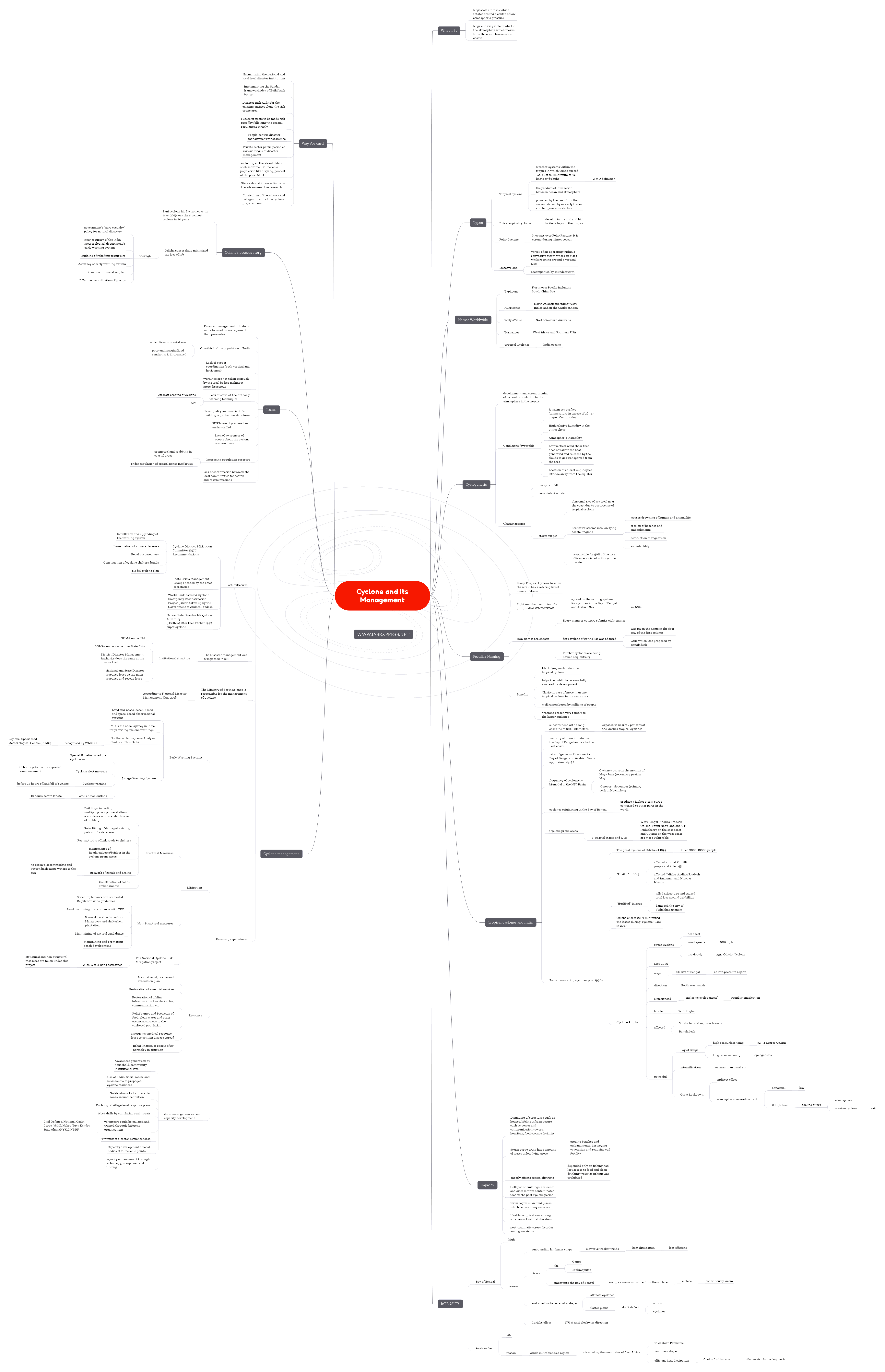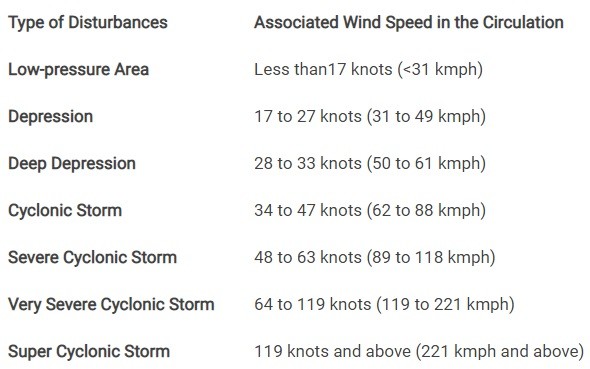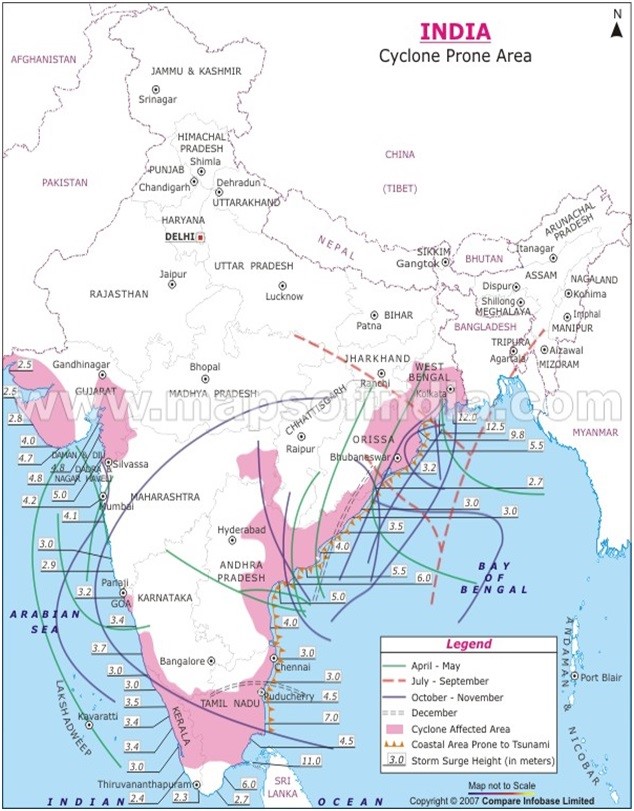[Disaster Series] Cyclones and its Management in India [Updated]

Updates *
India has to be prepared for many destructing disasters of which Cyclone is a critical challenge. India has a coastline of about 7,516 km (Mainland-5,400 km, Islands- 132 km in Lakshadweep and 1,900 km in the Andaman and Nicobar Islands). Though the North Indian Ocean Basin generates only around 7% of the world’s cyclones, the impact is higher and very devastating, especially when they strike the coasts along the North Bay of Bengal. The recent Amphan cyclone that struck the Bay of Bengal coast is a case in point. *
This topic of “[Disaster Series] Cyclones and its Management in India [Updated]” is important from the perspective of the UPSC IAS Examination, which falls under General Studies Portion.
What are cyclones?
- Cyclone is a largescale air mass that rotates around a centre of low atmospheric pressure.
- It is a large and very violent whirl in the atmosphere which moves from the ocean towards the coasts.
What are the types of Cyclones?
Tropical cyclones
- Tropical Cyclones are weather systems within the tropics in which winds exceed ‘Gale Force’ (minimum of 34 knots or 63 kph) (World Meteorological Organisation)
- Tropical cyclones are the product of the interaction between ocean and atmosphere. They are powered by the heat from the sea and driven by easterly trades and temperate westerlies.
Extratropical cyclones
- They develop in the mid and high latitudes beyond the tropics.
Polar Cyclone
- It occurs over Polar Regions. It is strong during the winter season.
Mesocyclone
- A mesocyclone is a vortex of air operating within a convective storm where air rises while rotating around a vertical axis. These are accompanied by a thunderstorm.
India mainly deals with the tropical cyclone as the peninsular region comes under the tropics. So, we will be discussing mainly tropical cyclones and their management.
What are the cyclones called worldwide?
Worldwide, the cyclones are known by different names
- Typhoons in Northwest Pacific including the South China Sea
- Hurricanes in North Atlantic including Weet Indies and in the Caribbean sea
- Willy-Willies in North-Western Australia
- Tornadoes in West Africa and Southern USA
- Tropical Cyclones in India oceans
What is cyclogenesis in tropics?
It is the development and strengthening of cyclonic circulation in the atmosphere in the tropics.
Listed below are some of the favourable conditions identified through some observable facts
- A warm sea surface (temperature in excess of 26–27-degree Centigrade) and associated warming
- High relative humidity in the atmosphere
- Atmospheric instability that promotes the formation of vertical cumulus clouds.
- Low vertical wind shear that does not allow the heat generated and released by the clouds to get transported from the area.
- Location of at least 4–5-degree latitude away from the equator in the intertropical convergence zone.
Tropical cyclones are characterised by heavy rainfall, very violent winds, storm surges impacting human and animal life. Storm surge, particularly, is responsible for 90% of the loss of lives associated with cyclone disaster.
What is a storm surge?
Storm surge is an abnormal rise of sea level near the coast due to occurrence of tropical cyclone. Sea water storms into low lying coastal regions. It causes drowning of human and animal life, erosion of beaches and embankments, destruction of vegetation and results in soil infertility.
Classification of Tropical cyclones
The Indian Meteorological Department classifies the tropical cyclones as below
Peculiar names of cyclones
Every Tropical Cyclone basin in the world has a rotating list of names of its own. Eight member countries of a group called WMO/ESCAP agreed on the naming system for cyclones in the Bay of Bengal and Arabian Sea region and the system came into effect in 2004.
How the names are chosen?
Every member country submits eight names. The first cyclone after the list was adopted was given the name in the first row of the first column — Onil, which was proposed by Bangladesh. Further cyclones are being named sequentially.
We have seen the peculiar names of cyclones like Katrina, Fani, Vayu etc. The naming of cyclones has the following benefits
- Identifying each individual tropical cyclone.
- It helps the public to become fully aware of its development.
- The clarity in case of more than one tropical cyclone in the same area.
- well-remembered by millions of people.
- Warnings reach very rapidly to the larger audience.
Tropical cyclones and India
- The subcontinent with a long coastline of 8041 kilometres is exposed to nearly 7 percent of the world’s tropical cyclones.
- The majority of them initiate over the Bay of Bengal and strike the East coast of India
- The ratio of the genesis of cyclone for the Bay of Bengal and the Arabian Sea is approximately 4:1.
- The frequency of cyclones is bi-modal in the NIO Basin. Cyclones occur in the months of May–June (secondary peak in May) and October–November (primary peak in November)
- Tropical cyclones originating in the Bay of Bengal which strikes the east coast of India and Bangladesh usually produce a higher storm surge compared to other parts in the world.
The cyclone-prone regions in India
What are the Impacts of the cyclone?
- Damaging of structures such as houses, lifeline infrastructure such as power and communication towers, hospitals, food storage facilities, roads, bridges, culverts, crops, etc., due to high-velocity winds
- Storm surge brings a huge amount of water in low-lying areas of the coastal areas resulting in loss of life and property, besides eroding beaches and embankments, destroying vegetation and reducing soil fertility
- The cyclone mostly affects coastal districts. Several people in coastal villages who depended only on fishing had lost access to food and clean drinking water as fishing was prohibited
- The collapse of buildings, accidents and disease from contaminated food in the post-cyclone period is also the reason for the loss of life.
- A flood caused by the cyclone can cause water log in unwanted places which causes many diseases.
- Coastal areas find difficult without power supply, communication, emergency responses due to cyclones
- Health complications among survivors of natural disasters without emergency relief from the organizations can also rise the death rate even after the danger has passed
- Confronted with scenes of destruction and death of friends and loved ones many children develop post-traumatic stress disorder
Why are cyclones in the Bay of Bengal more intense than in the Arabian Sea?
- Though cyclones arise on both the coasts of India, those from the Bay of Bengal are markedly more intense and damaging due to various geographical reasons.
- The winds in the Arabian Sea region are directed by the mountains of East Africa towards the Arabian Peninsula due to the landmass shape.
- This has a role in efficient heat dissipation in the region. As a result, the Arabian Sea waters are relatively cooler- unfavourable for cyclogenesis.
- In the Bay of Bengal region, the surrounding landmasses’ shape makes the winds slower and weaker. As a result, heat dissipation is less efficient.
- Several rivers like the Ganga and the Brahmaputra empty into the Bay of Bengal. The waters from these rivers rise up as warm moisture from the surface. The result is that the Bay of Bengal water surface is continuously warm and the moisture is ready to feed and intensify any cyclone in the region.
- The east coast’s characteristic shape attracts cyclones. Odisha’s position at the curve of the peninsula makes it an easy target for such cyclones.
- The Bay of Bengal cyclones move in the north-west and anti-clockwise direction due to the Coriolis effect.
- Apart from this, the flatter plains of the east coast don’t help in deflecting winds and incoming cyclones.
Some of the devastating cyclones which affected India since 1990
- The great cyclone of Odisha of 1999 killed 9000-10000 people.
- “Phailin” in 2013 affected around 12 million people and killed 45 with the losses of around 260 billion rupees. It affected Odisha, Andhra Pradesh and Andaman and Nicobar Islands.
- “HudHud” in 2014 that killed at least 124 and caused total loss around 219 billion rupees. It damaged the city of Vishakhapatnam.
What was Cyclone Amphan? *
- Cyclone Amphan was a super-cyclone that developed in May 2020. Super-cyclones are the deadliest category of cyclones with wind speeds of over 200kmph.
- It is the first such super-cyclone since the 1999 Odisha Cyclone for which the category itself was introduced.
- It is the first cyclone of the 2020 North Indian Cyclone season.
- It originated in the Southeast region of Bay of Bengal as a low-pressure region.
- Amphan was subject to destabilization by wind shears in the initial stages when it brought torrential rains to the southern coasts. However, as it proceeded north-westwards, it experienced more stable conditions.
- It experienced a phenomenon called ‘explosive cyclogenesis’- a process of rapid intensification.
- Amphan turned into a ‘bomb cyclone’ or ‘weather bomb’- i.e rapid intensification in a span of few hours. By the time it neared the land, its top was more than 1,000 km wide.
- It made landfall at West Bengal’s Digha. It is the deadliest cyclone in the Bay of Bengal in the 21st
- It also affected the Sundarbans Mangrove Forests and the neighbouring country of Bangladesh.
Why was Amphan so powerful? *
- The main reason was the high sea surface temperatures in the Bay of Bengal (32 to 34 degree Celsius).
- Long-term warming of the Bay of Bengal contributed to such conditions favouring cyclogenesis.
- Warmer than usual air also contributed to the intensification.
- Recent studies suggested that the Great Lockdown had an indirect effect on Amphan’s intensification as the atmospheric aerosol content was abnormal.
- The reduced economic activity had drastically brought down the atmospheric aerosol in the South Asian region.
- A high level of aerosol (atmospheric pollutants) has a cooling effect on the atmosphere and tends to weaken cyclones. Such was the case with May 2019 Fani where the cyclone wasn’t as severe despite the exceptionally high sea surface temperatures.
- This effect is observed as the pollutant particles stimulate the clouds to precipitate as rain occur prematurely and impede cyclone’s growth.
Cyclone management in India
The cyclones, being a natural phenomenon, is mostly unavoidable. Hence the main focus should be on preparedness, mitigation, adaptation, adequate response.
Past Initiatives
- Cyclone Distress Mitigation Committee (1970) Recommendations
- Installation and upgrading of the warning system;
- Demarcation of vulnerable areas;
- Relief preparedness;
- Construction of cyclone shelters, bunds or
embankments - Model cyclone plan
- educational awareness;
- A calamity fund
- Based on the recommendations of High-Powered Committee (HPC) on Disaster Management, (1999) state governments have set up State Crisis Management Groups headed by the chief secretaries
- World Bank-assisted Cyclone Emergency Reconstruction Project (CERP) taken up by the Government of Andhra Pradesh in 1990 itself following the severe cyclone of May 1990
- The Government of Orissa constituted the Orissa State Disaster Mitigation Authority
(OSDMA) after the October 1999 super cyclone - The Disaster Management Act was passed in 2005.
- Under DM act, the institutional structure was created for disaster management. Its structure is as follows
- The National Disaster Management Authority under Prime Minister at the Central Level and State Disaster Management Authorities at the state level to lay down policies, plans and guidelines for disaster management and coordinating their enforcement and implementation of the same
- District Disaster Management Authority does the same at the district level
- National and State Disaster response force as the main response and rescue force.
- Under DM act, the institutional structure was created for disaster management. Its structure is as follows
According to the 2016 blueprint of the National Disaster Management Plan, The Ministry of Earth Science is responsible for the management of Cyclone.
Disaster preparedness generally takes the following course of the action plan- Early warning, Mitigation, Response, Awareness generation, and capacity development.
Early Warning Systems
By developing a system of issuing accurate forecasts and warnings in a form that is readily understood, lives and property can be protected
- India Uses land-based, ocean-based and space-based observational systems which include conventional meteorological observations, reports from ships, observations from ocean data buoys, coastal radars (conventional and Doppler) and national and international satellites
- IMD is the nodal agency in India for providing cyclone warnings
- Northern Hemispheric Analysis Centre at New Delhi has been designated as a Regional Specialised Meteorological Centre (RSMC) for Tropical cyclones. It is one of six such centres in the world recognised by WMO under a global system of cyclone warnings
Existing 4 stage Warning System
- Special Bulletin called pre cyclone watch containing potential indications of the development of cyclone
- Cyclone alert message 48 hours prior to the expected commencement
- Cyclone warning before 24 hours of the landfall of cyclone
- Post Landfall outlook 12 hours before landfall
Mitigation
Mitigation measures are of two types
- Structural Measures
- Buildings, including multipurpose cyclone shelters in accordance with standard codes of the building
- Retrofitting of damaged existing public infrastructure
- Restructuring of link roads to shelters
- Roads/culverts/bridges in the cyclone-prone areas need to be well maintained and given utmost attention
- The network of canals and drains to receive, accommodate and return back surge waters to the sea
- Construction of saline embankments
- Non-Structural measures
- Strict implementation of Coastal Regulation Zone guidelines
- Land-use zoning in accordance with CRZ
- Natural bio-shields such as Mangroves and shelterbelt plantation
- Maintaining of natural sand dunes
- Maintaining and promoting beach development
The National Cyclone Risk Mitigation project
The Government of India implements the National Cyclone Risk Mitigation Project (NCRMP) with World Bank assistance. The above structural and non-structural measures are taken under this project.
Response
Response measures are those which are taken immediately prior to and following a cyclone.
It consists of
- A sound relief, rescue and evacuation plan
- Restoration of essential services
- Restoration of lifeline infrastructure like electricity, communication, etc
- Relief camps and Provision of food, clean water and other essential services to the sheltered population
- The emergency medical response force to contain disease spread.
- Rehabilitation of people after normalcy in the situation.
Awareness generation and capacity development
Awareness generation about cyclone risk and response in the target audience, especially women, children, old people, and divyang people is of utmost importance.
- Awareness generation at the household, community, institutional level
- Use of Radio, Social media and news media to propagate cyclone readiness
- Notification of all vulnerable zones around habitation
- Evolving of village-level response plans
- Mock drills by simulating real threats
- volunteers could be enlisted and trained through different organisations
like the Civil Defence, National Cadet Corps (NCC), Nehru Yuva Kendra Sangathan (NYKs), NDRF etc - Training of disaster response force
- Capacity development of local bodies at vulnerable points
- Institutional capacity enhancement through technology, manpower, and funding
What are the issues with Cyclone management In India?
- Disaster management in India is more focused on management than prevention.
- One-third of the population of India which lives in the coastal area is poor and marginalized rendering it ill-prepared and unable to cope up with a disaster.
- Lack of proper coordination (both vertical and horizontal)
- In the recent Ockhi cyclone disaster, it was seen that the warnings were not taken seriously by the local bodies making it more disastrous.
- Lack of state-of-the-art early warning techniques such as Aircraft probing of the cyclone, UAVs.
- Poor quality and unscientific building of protective structures.
- The State disaster response forces are ill-prepared to respond. So, the onus of response always falls on the NDRF rendering golden hour response unavailable.
- Lack of awareness of people about the cyclone preparedness which causes repeating mistakes of chaos and lack of coordinated response.
- Increasing population pressure and corrupt practices render regulation of coastal zones ineffective. The population bulge at the coasts is in danger forever.
- There is also a lack of coordination between the local communities for search and rescue missions
The Odisha Success Story: A case study
- The Fani cyclone hit the East coast in May 2019 was the strongest cyclone in 20 years.
- Odisha successfully minimized the loss of life in a dramatic manner.
- The government’s “zero casualties” policy for natural disasters and the near accuracy of the India meteorological department’s early warning system have helped reduce the possibility of deaths from cyclone Fani.
- It was achieved through
- Building relief infrastructure
- Accuracy of early warning system
- Clear communication plan
- Effective co-ordination of groups
- The United Nations Office for Disaster Risk Reduction (UNISDR) hailed government and volunteer efforts in the response to Fani
Way forward
- Harmonizing the national and local level disaster institutions to better coordinate.
- Implementing the Sendai framework idea of Build back better.
- Disaster Risk Audit for the existing entities along the risk-prone area.
- Future projects to be made risk proof by following the coastal regulations strictly.
- People-centric disaster management programmes must be formed.
- Private sector participation at various stages of disaster management is necessary to tap into its potential.
- Inclusive disaster management regime by including all the stakeholders such as women, vulnerable populations like divyang, poorest of the poor, NGOs with expertise in post-disaster relief work, etc.
- States should increase focus on the advancement in research to create homegrown solutions to the disaster issues.
- The curriculum of the schools and colleges must include cyclone preparedness.
- The Odisha government’s success in minimizing casualties in recent Fani cyclone must be emulated by other states.
Practise question for mains
Disaster management in India has come a long way. Discuss with reference to the response to Cyclone Fani. Discuss. Suggest further measures to fill the gaps. (250 words)




explained in detail… thank you